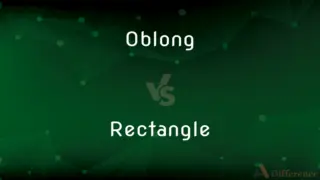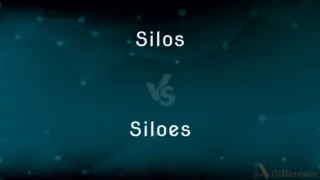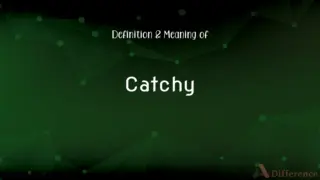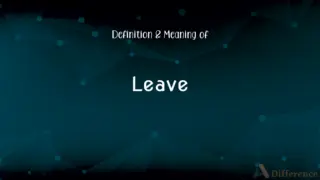Thanksgiving in America vs. Thanksgiving in Canada — What's the Difference?
By Tayyaba Rehman — Published on February 13, 2024
Thanksgiving in America is celebrated on the fourth Thursday of November, focusing on historical events. Thanksgiving in Canada is observed on the second Monday of October, emphasizing gratitude for the harvest season.
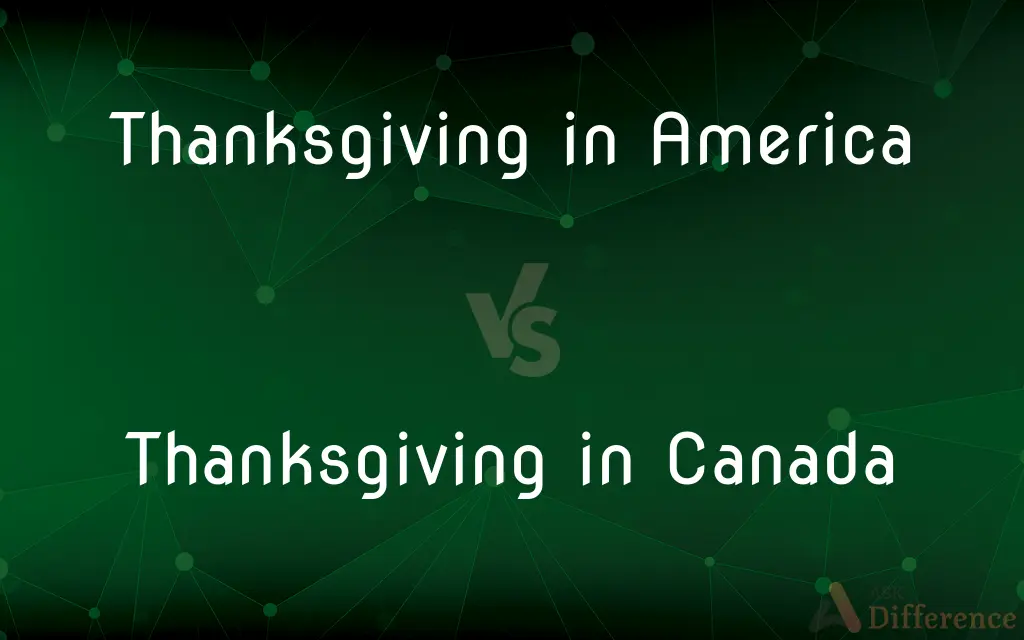
Difference Between Thanksgiving in America and Thanksgiving in Canada
Table of Contents
ADVERTISEMENT
Key Differences
Thanksgiving in America, celebrated on the fourth Thursday of November, commemorates the Pilgrims' harvest feast with Native Americans in 1621. The holiday is marked by a traditional meal, including turkey, stuffing, and pumpkin pie. It often involves parades, football, and expressing gratitude for blessings.
Thanksgiving in Canada falls on the second Monday of October and traces its roots to European traditions. Canadians gather to give thanks for the harvest and blessings of the past year. The celebration typically includes a festive meal with turkey, cranberry sauce, and seasonal vegetables. It is a time for family gatherings and expressing appreciation.
Comparison Chart
Date of Celebration
Fourth Thursday of November
Second Monday of October
Historical Emphasis
Commemorates the Pilgrims' 1621 harvest feast
Traces roots to European harvest traditions
Traditional Meal
Turkey, stuffing, pumpkin pie
Turkey, cranberry sauce, seasonal vegetables
ADVERTISEMENT
Cultural Observances
Parades, football, expressing gratitude
Family gatherings, expressing appreciation
Historical Significance
Pilgrims and Native American interaction
European harvest traditions and gratitude
Compare with Definitions
Thanksgiving in America
Celebrated on the fourth Thursday of November.
Thanksgiving in America always falls on the fourth Thursday, creating a long weekend for many.
Thanksgiving in Canada
Traditional meal includes turkey and cranberry sauce.
Thanksgiving in Canada is incomplete without a delicious meal featuring turkey and cranberry sauce.
Thanksgiving in America
Often involves parades and football activities.
Parades and football games are integral parts of Thanksgiving in America, enhancing the festive spirit.
Thanksgiving in Canada
A day for expressing appreciation and gratitude.
Thanksgiving in Canada is a heartfelt appreciation day, bringing families together to give thanks for abundance.
Thanksgiving in America
Expressing gratitude for harvest blessings.
Families come together during Thanksgiving in America to share a meal and express gratitude for the year's blessings.
Thanksgiving in Canada
Traces its roots to European harvest traditions.
Thanksgiving in Canada has European origins, reflecting a celebration of the harvest season.
Thanksgiving in America
Thanksgiving in America commemorates the Pilgrims' 1621 harvest feast.
Thanksgiving in America reflects on the Pilgrims' feast, symbolizing unity and gratitude.
Thanksgiving in Canada
Celebrated on the second Monday of October.
Canadians mark Thanksgiving on the second Monday, enjoying a long weekend with family and friends.
Thanksgiving in America
A national tradition with historical significance.
Thanksgiving in America is deeply ingrained in the national culture, emphasizing the importance of gratitude and togetherness.
Thanksgiving in Canada
Emphasizes the importance of harvest and festivities.
Canadians celebrate Thanksgiving with harvest-themed decorations and festivities, creating a warm and welcoming atmosphere.
Common Curiosities
When is Thanksgiving in Canada observed?
Thanksgiving in Canada is observed on the second Monday of October.
What is the historical origin of Thanksgiving in Canada?
It traces its roots to European harvest traditions.
When is Thanksgiving in America celebrated?
Thanksgiving in America is celebrated on the fourth Thursday of November each year.
What is a typical meal during Thanksgiving in Canada?
A typical meal includes turkey, cranberry sauce, and seasonal vegetables.
What historical event does Thanksgiving in America commemorate?
It commemorates the Pilgrims' harvest feast with Native Americans in 1621.
Is there a historical significance to Thanksgiving in Canada?
Thanksgiving in Canada emphasizes gratitude for the harvest season and blessings of the past year.
What cultural observances are common during Canadian Thanksgiving?
Family gatherings and expressing appreciation for blessings are common during Thanksgiving in Canada.
Is Thanksgiving in Canada a public holiday?
Yes, Thanksgiving in Canada is a public holiday, observed with a day off for many.
Are parades and football common during Thanksgiving in America?
Yes, parades and football activities are integral parts of Thanksgiving celebrations.
How does Thanksgiving in Canada differ from Thanksgiving in America?
While both express gratitude, Thanksgiving in Canada has European roots, and the dates of celebration differ.
What is a traditional meal during Thanksgiving in America?
The traditional meal includes turkey, stuffing, and pumpkin pie.
What is a specific dish associated with Thanksgiving in Canada?
Cranberry sauce is a traditional dish commonly associated with Thanksgiving meals in Canada.
What day of the week is Thanksgiving in Canada usually observed?
Thanksgiving in Canada is observed on the second Monday, creating a long weekend for Canadians.
Is there a national tradition associated with Thanksgiving in Canada?
Thanksgiving in Canada is a national tradition, reflecting the importance of harvest and appreciation for abundance.
How do Canadians typically celebrate Thanksgiving?
Canadians celebrate Thanksgiving with family gatherings, festive meals, and expressions of gratitude.
Share Your Discovery

Previous Comparison
Bleached Flour vs. Unbleached Flour
Next Comparison
EMT vs. ParamedicAuthor Spotlight
Written by
Tayyaba RehmanTayyaba Rehman is a distinguished writer, currently serving as a primary contributor to askdifference.com. As a researcher in semantics and etymology, Tayyaba's passion for the complexity of languages and their distinctions has found a perfect home on the platform. Tayyaba delves into the intricacies of language, distinguishing between commonly confused words and phrases, thereby providing clarity for readers worldwide.












